Menus
- Test: Superbikes between 600 and 750 cubic meters
- MOTORCYCLE scoring
- MOTORCYCLE test result
- Technical specifications
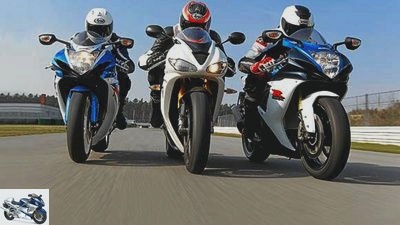
Photos: fact
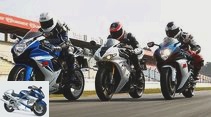
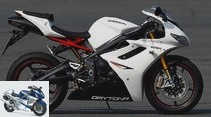
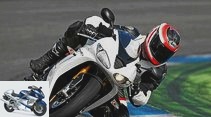
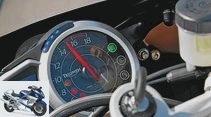
18th photos
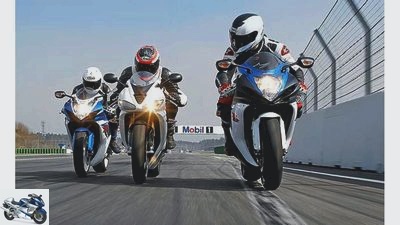
1/18
Suzuki GSX-R 600, Triumph Daytona 675 R, Suzuki GSX-R 750.
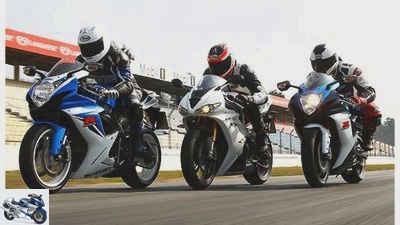
2/18
From left: Suzuki GSX-R 600, Triumph Daytona 675 R, Suzuki GSX-R 750.
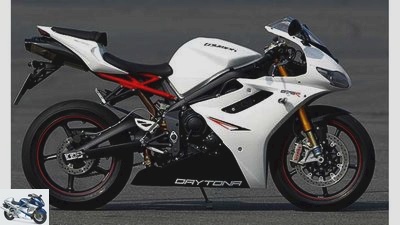
3/18
Triumph Daytona 675 R
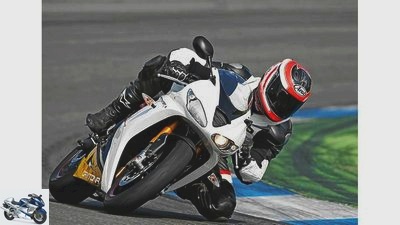
4/18
The Golden middle? Somehow yes, although the similarities with the Suzukis are limited. It’s hard to find a more independent motorcycle than the Daytona. Whether it has to be the R depends on your personal needs.

5/18
Triumph Daytona 675 R Cockpit: One cylinder less, more displacement – and still, fun doesn’t stop until 15,000 rpm. Shortly afterwards the limiter interferes very decisively.
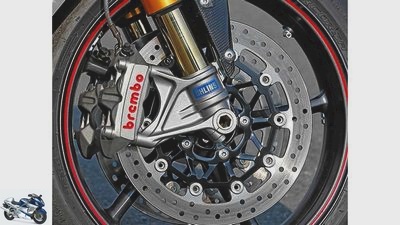
6/18
The brakes of the Triumph act like the two Suzukis: simply good all round.
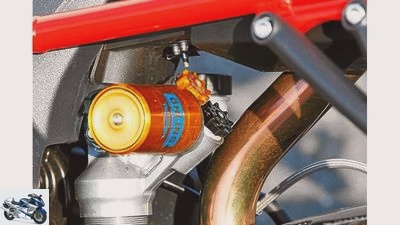
7/18
Triumph Daytona 675 R: The Ohlins TTX shock absorber is a tough case despite the barely pre-tensioned spring and the damping turned up a lot, the fork is a bit more flexible.
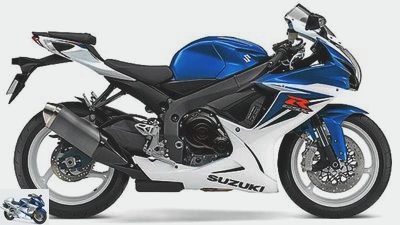
8/18
Suzuki GSX-R 600.
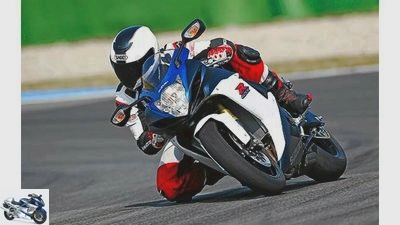
9/18
Not bigger, but stronger. And the GSX-R 750 feels much more different than its visual proximity to its little sister suggests. A case to try out.
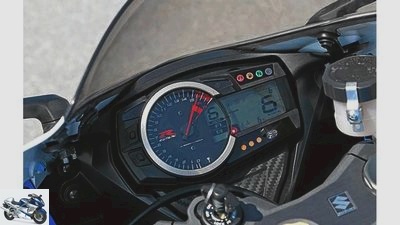
10/18
Suzuki GSX-R 600 Cockpit: You should recognize them by their rev counters. The red area begins at a good 15,000 rpm, and much later it runs gently into the limiter. A and B modes (under the gear indicator) are more used for play instinct than for everyday practice, mode B, with its radical reduction in peak power, only makes sense in heavy rain.

11/18
The shock absorber is more at home on the hard side.
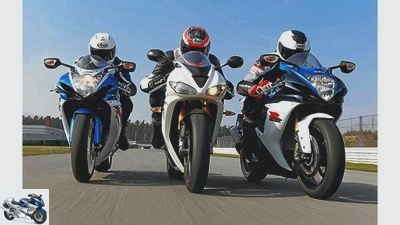
12/18
Less is more. The traditional creed.
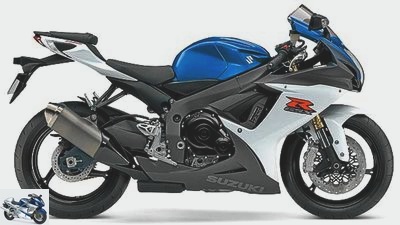
13/18
The Suzuki GSX-R 750.
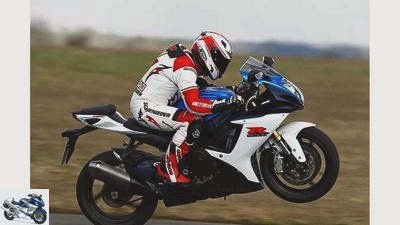
14/18
The Suzuki GSX-R 750 makes "male".
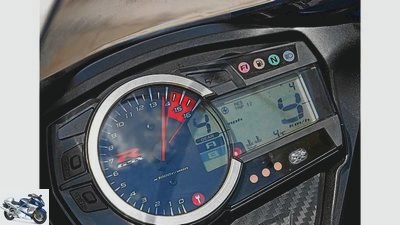
15/18
Cockpit of the Suzuki GSX-R 750: Exactly 1000 rpm earlier than on the GSX-R 600, the red area begins with the big sister. The shift light with a diode band is clearly visible.
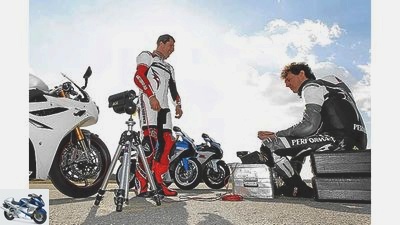
16/18
A break is a must – MOTORCYCLE measurements can be exhausting.
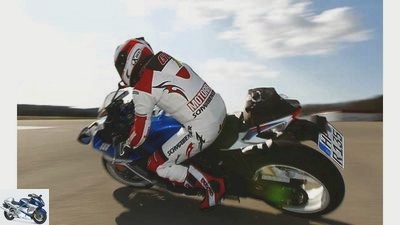
17/18
The "small" Super athletes do well in the handling course.
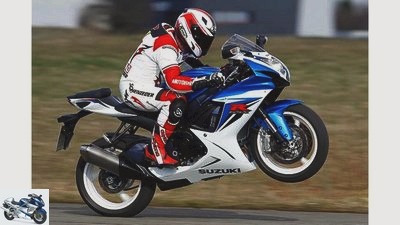
18/18
The GSX-R 600 on the rear wheel.
Supersport comparison test: Suzuki against Triumph
Test: Superbikes between 600 and 750 cubic meters
With all the 200 hp euphoria and all the electronics hype, we almost forgot: As a super sports car, you can also pay homage to the traditional credo. Less is more.
They exist, those moments in which you go into yourself. Critically asks: How did that happen? Do we really need 200 TV programs? Is it worth striving to be reachable with the mobile phone anytime and anywhere? Or: When and why we only got this feeling that it had to be at least 1000 cubic centimeters and 180 hp?
One of those reflective moments is undoubtedly meeting the latest Suzuki and Triumph super athletes. 600, 675 and 750 cubic centimeters, nominally between 124 (Triumph) and 150 PS (GSX-R 750) – that is far from the current performance fetishism. But – you guessed it – probably closer to what can be controlled stress-free on and off closed-off routes even without electronic aids.
At Suzuki there is again an attractive option for this year. Namely the one to try out in one and the same chassis, whether one of the irrepressible hunger for revs GSX-R 600 is more appealing than the compromise between 600 rpm and 1000 torque, with which the big 750 sister has served a loyal following for years. And with Triumph, too, you have to make a decision since this model year. Between the standard Daytona and the sporty sister 675 R, which already differs optically from the civilian Daytona with the red rear frame and the Ohlins spring elements as well as the numerous real carbon applications.
Buy complete article
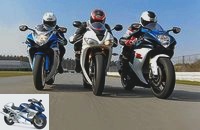
Supersport comparison test: Suzuki against Triumph
Test: Superbikes between 600 and 750 cubic meters
GSX-R 750 demand a little more emphasis when turning, but rather the larger rotating masses. In any case, the little sister’s handling is even more light-footed.
Suzuki GSX-R 600, Triumph Daytona 675 R, Suzuki GSX-R 750.
That doesn’t mean that the 750 is an immovable block. On the contrary. Probably seldom met the winged word of "good compromise" more clearly than here. Especially when it comes to the engine. With a nominal 150 PS, it is located almost exactly between the 120 PS benchmark for Supersport 600s and the brutal 180 PS of most 1000s, the 750 in-line four meets all requirements, at least in civilian use. In the latest version, it does even more. With its growling bark from the airbox, its spontaneous throttle response and the extremely lively acceleration
It not only noticeably puts the little sister’s 600 in its place, but also conveys a good portion of the exuberance that customers particularly valued about the legendary 1000-series quad of the K5 / K6 generation and which is legendary to this day. In view of this, one is quickly ready to forgive that this generation of 750 engines does not deliver the promised performance either and, with 139 hp, is well below the proclaimed 150 hp. After all, these 139 hp are enough to easily accelerate from 0 to 100 km / h at 1000 level and lose nothing even at 140 km / h. Only later, beyond 140 km / h, can the “Thousand” cars move away and land from 0 to 200 km / h between seven and eight seconds, while the 750 with 8.6 seconds takes around half a second more time. But even with this value, the GSX-R 750 is clearly closer to the great athletes than to the 600 sister or the 675 Daytona, who keep a respectful distance.
In contrast, it looks different with the everyday relevant pull-through test. The GSX-R 750 can keep its little sister at a distance, but now is the day of the Daytona. Or better: that of the three-cylinder. Now he’s unpacking really big. Because this fascinating drive is still captivating in its fifth model year with virtues that are unique in this displacement class. Its grinding, guttural sound is incomparable, its lively response behavior is exemplary, its power output is impressive. For everyone for whom this is too flowery, a solid reading: from 60 to 100 km / h it not only clearly distances the GSX-R 750 when pulling through in the last gear. No, he’s even on par with some of the superbike armada members. The new Kawasaki ZX-10R, for example, or the Ducati 1198 SP, while it leaves a MV Agusta F4 far behind.
That is a strong piece indeed. It is even better that Hinckley has so far put this extremely strong and unique triple in a chassis that has also defined the class standard in terms of handling, feedback and neutrality for years.
The GSX-R 600 on the rear wheel.
Mind you, in the basic version. The expectations of the R are high – and fully met. At least when it comes to a brisk lap on the racetrack. Here, where there is hardly a hump or frost breakout and where the most important thing is as little weight transfer and stability as possible during tough braking maneuvers or brutal acceleration orgies, the tightly tuned Ohlins fork and the TTX-36 spring strut with a hard 110 spring are in yours Element. But when it comes to suitability for everyday use (and this also means the courageous ride on the home route), even the proud R owner will sometimes want the basic spring goods back. And with it the balanced coordination with which the Daytona has so far shone.
Before misunderstandings arise: Even in the R configuration, the Brit is a great motorcycle. But also a much more uncompromising one. It is no longer as supple as it was known to be. Take the fork, for example: In view of the hard springs and its rich damping, it is still surprisingly sensitive, but cannot serve the comfort of the basic variant. In addition, it doesn’t dive that far when braking – and thus noticeably worsens the previously balanced steering behavior. A similar classification applies to the shock absorber: a fascinating component – but too hard for everyday use. And therefore not an absolute recommendation for anyone who does not drive their Daytona for trophies or in race training.
The same applies to another accessory that ennobles the R to a hit. The automatic gearshift is always a help when the throttle valve and speed are at the limit. Half-hearted upshifts in the partial load range and medium speed range, however, are acknowledged by the engine with significant misfires and jerky throttle response, so that conventional shifting work with the aid of the clutch is available on the way to work. Anyone who does this will still enjoy the brilliant performance of the engine without regrets, leaving time and space to enjoy the other strengths of the Daytona. The Brembo Monobloc four-piston calipers (identical to the GSX-R stoppers by the way) are undoubtedly one of them. They can be dosed splendidly and bite mercilessly. The perfect knee fit on the narrow tank is always particularly noticeable when changing from the Suzuki, which is wide in this area. In addition, the timeless design of the Daytona deserves a mention. The slim appearance, paired with almost Italian elegance – that has something. In addition, the two GSX-R look a bit pleasing and interchangeable.
Not bigger, but stronger. And the GSX-R 750 feels much more different than its visual proximity to its little sister suggests. A case to try out.
A matter of taste, you say? Certainly. Just like the question of whether 600 or 750 GSX-R cubic centimeters are the right choice. Because even if there is a lot to be said for the larger-displacement variant in everyday life, you can definitely succumb to the appeal of the high engine speed. On the way to work – but even more so on the home route, where a skilfully squeezed GSX-R 600 hardly needs to fear an opponent. Why? Because these are the moments when everything comes together and merges into a dynamic whole. A high-performance engine like this never accelerates more smoothly than at just under five-digit speeds; the power delivery is never so emphatic and at the same time predictable. Switch? Usually does not have to be, because even such a 600 has an immensely wide usable speed range. The range extends from around 8,000 rpm to around 15,000 rpm. However, this means speeds between 95 and 175 km / h in third gear, while the big sister provides the same power on the rear wheel (see diagrams on page 31) at 80 km / h.
So the second, sometimes even the first, course is necessary to enjoy the power and glory of the 600. You have to like that, and you have to expect it from your environment. Or you can take it easy, enjoy the cultivated responsiveness and a courageous start in the lower speed range for this class. Because let’s not fool ourselves: what the little four-of-a-kind provides from around 5000 rpm is enough for the cozy evening round. The tachometer needle should not fall under this, however, because the engine falls around 1000 revolutions lower into a pronounced torque hole.
Like the big sister, by the way. Only that it is naturally not so noticeable with the larger displacement. That’s why – but also because this wonderful airbox growl is present much earlier on the 750 – you like to go in deep gear with the large GSX-R. In order to then notice when switching to the Daytona that its triplet is still more emphatic at this speed.
Two fresh GSX-R sisters who are convincing in every respect. And a classy Daytona variant that has everything that amateur racing drivers could want. That leaves the matter with the coal. The GSX-R 600 costs around 12,000 euros including ancillary costs, the Daytona 675 R just over 13,000 euros and the GSX-R 750 over 13,300 euros. Especially when you look at what some manufacturers are currently asking for 1000 models from 2010. One could become weak and yet succumb to the call of abundance. But you will never experience the enormous driving pleasure you can have at the base.
MOTORCYCLE scoring
Less is more. The traditional credo.
engine
A question of displacement, but not only. Of course, the driving performance largely decides on victory or defeat in the chapter "engine", and the 750 has the edge. But the triumph three-of-a-kind does well and is even best when it comes to pulling through. And even the small 600 is a big one in its class and with good manners keeps the distance manageable.
Winner engine: GSX-R 750
landing gear
The small really big: Despite largely identical chassis, the small GSX-R can keep its big sister at a distance in this chapter. In the chapter "Handling" anyway, but also when it comes to the more comfortable coordination of the spring elements. This is exactly what the Daytona R suffers from, while its handling qualities cannot be beaten.
Winner chassis: GSX-R 600
everyday life
The hour of the Suzuki: the design of the Daytona R is too radically trimmed for the racetrack to be seen here in everyday life. It starts with ergonomics and doesn’t stop when you look in the rearview mirror. Yes, even with the light, the Japanese shine brighter and top it all with a great range because of the sensationally low consumption.
Winner everyday life: GSX-R 750
security
Stalemate situation: identical brakes with great function, no ABS, thanks to electronically controlled (Suzuki) or tightly tuned steering dampers (Triumph) no approach to handlebar slap – in the chapter "security" there is agreement.
Security winner: tie
costs
The Daytona makes up for the higher consumption with long inspection intervals.
Winner Cost: Daytona
| Max points | Suzuki GSX-R 600 | Suzuki GSX-R 750 | triumph | |
| Overall rating | 1000 | 682 | 690 | 667 | placement | 2. | 1. | 3. |
| Price-performance note | 1.0 | 1.9 | 1.6 | 2.1 |
Price-performance
It stays tuned in terms of points and has the cheapest price: the GSX-R 600.
Price-performance winner: GSX-R 600
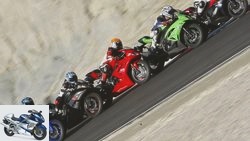
motorcycles
Honda CBR 600 RR, Kawasaki Ninja ZX-6R, Suzuki GSX-R 600, Triumph Daytona 675, Yamaha YZF-R6
A comparison of the 600 super sports car
read more
MOTORCYCLE test result
The Suzuki GSX-R 750.
1. Suzuki GSX-R 750
"Where are they then??" Hats off, the new GSX-R 750 has turned out to be a really good motorcycle. It fills the gap between the superbikes and the small 600s perfectly. An attractive alternative to the bolides.
2. Suzuki GSX-R 600
The small GSX-R has also gained a lot with the revision and is the standard in its class. In everyday life, she clearly distances her athletic triumph.
3rd Triumph Daytona 675 R
Even in the fifth model year, the Daytona is still up to date. The R variant, however, exaggerates sportiness for everyday use. Less would have been more here.
Technical specifications
The brakes of the Triumph act like the two Suzukis: simply good all round.
Suzuki GSX-R 600
| engine | design type | Four-cylinder, four-stroke in-line engine |
| injection | Ø 40 mm | coupling | Multi-disc oil bath clutch (anti-hopping) |
| Bore x stroke | 67.0 x 42.5 mm | Displacement | 599 cm3 |
| compression | 12.9: 1 | power | 92.5 kW (126 hp) at 13500 rpm |
| Torque | 70 Nm at 11500 rpm | landing gear |
| frame | Bridge frame made of aluminum | fork | Upside-down fork, Ø 41 mm |
| Brakes v / h | electronic steering damper | Assistance systems | Ø 310 mm / Ø 220 mm |
| bikes | 3.50 x 17; 5.50 x 17 | tires | 120/70 ZR 17; 180/55 ZR 17 |
| Tires | Bridgestone BT 016 AA | mass and weight |
| wheelbase | 1385 mm | Steering head angle | 66.3 degrees |
| trailing | 97 mm | Suspension travel v / h | 120/130 mm |
| Seat height * | 810 mm | Weight with full tank * | 190 kg |
| Payload | 190 kg | Tank capacity | 17.0 liters |
| Service intervals | 6000 km | price | 11890 euros |
| Additional costs | 190 euros |
Suzuki GSX-R 750
| engine | design type | Four-cylinder, four-stroke in-line engine |
| injection | Ø 42 mm | coupling | Multi-disc oil bath clutch (anti-hopping) |
| Bore x stroke | 70.0 x 48.7 mm | Displacement | 750 cm3 |
| compression | 12.5: 1 | power | 110.3 kW (150 PS) at 13,200 rpm |
| Torque | 86 Nm at 11200 rpm | landing gear |
| frame | Bridge frame made of aluminum | fork | Upside-down fork, Ø 41 mm |
| Brakes v / h | electronic steering damper | Assistance systems | Ø 310 mm / Ø 220 mm |
| bikes | 3.5 x 17; 5.5 x 17 | tires | 120/70 ZR 17; 180/55 ZR 17 |
| Tires | Bridgestone BT 016 G | mass and weight |
| wheelbase | 1390 mm | Steering head angle | 66.3 degrees |
| trailing | 97 mm | Suspension travel v / h | 120/130 mm |
| Seat height * | 805 mm | Weight with full tank * | 195 kg |
| Payload | 185 kg | Tank capacity | 17.0 liters |
| Service intervals | 6000 km | price | 13140 euros |
| Additional costs | 190 euros |
Triumph Daytona 675 R
| engine | design type | Three-cylinder four-stroke in-line engine |
| injection | Ø 44 mm | coupling | Multi-disc oil bath clutch |
| Bore x stroke | 74.0 x 52.3 mm | Displacement | 675 cm3 |
| compression | 12.65: 1 | power | 91.0 kW (124 hp) at 12600 rpm |
| Torque | 72 Nm at 11700 rpm | landing gear |
| frame | Bridge frame made of aluminum | fork | Upside-down fork, Ø 41 mm |
| Brakes v / h | Steering damper | Assistance systems | Ø 308 mm / Ø 220 mm |
| bikes | 3.50 x 17; 5.50 x 17 | tires | 120/70 ZR 17; 180/55 ZR 17 |
| Tires | Pirelli Diablo Supercorsa SP | mass and weight |
| wheelbase | 1395 mm | Steering head angle | 66.1 degrees |
| trailing | 89 mm | Suspension travel v / h | 110/130 mm |
| Seat height * | 830 mm | Weight with full tank * | 191 kg |
| Payload | 190 kg | Tank capacity | 17.4 liters |
| Service intervals | 10000 km | price | 12740 euros |
| Additional costs | 350 Euro |

motorcycles
Honda CBR 600 RR, Kawasaki Ninja ZX-6R, Suzuki GSX-R 600, Triumph Daytona 675, Yamaha YZF-R6
A comparison of the 600 super sports car
read more
archive
The thing is clear on the crankshaft: the Daytona triple can keep up with the larger GSX-R-750 drive up to around 4500 rpm, after which the four-in-line says goodbye. However, the gap between the little GSX-R sister and the British woman is even clearer. The 600 is always and everywhere clearly below the three-cylinder, with its 119 hp it cannot keep up with its peak performance. Also noticeable is his drop in the engine speed cellar at 4000 rpm. It is precisely in the lower speed range in which the 600 does well compared to its four-cylinder class competition. Just not in comparison to the three-cylinder triple.
Suzuki GSX-R 600
| Performance | Top speed * | 260 km / h |
| acceleration | 0-100 km / h | 3.4 sec |
| 0-140 km / h | 5.0 sec | 0-200 km / h | 10.1 sec |
| Draft | 60-100 km / h | 5.0 sec |
| 100-140 km / h | 4.6 sec | 140-180 km / h | 4.6 sec | Driving dynamics | Handling course I (fast slalom) | Lap time | 19.7 sec |
| vmax at the measuring point | 108.8 km / h | Handling course II (slow slalom) | Lap time | 28.8 sec |
| vmax at the measuring point | 52.1 km / h | consumption |
| Country road | 4.1 liters / super | Reach country road | 415 km |
* Manufacturer information
archive
Third gear traction: If you consider the tractive force on the rear wheel in third gear, which is often used on country roads and at a typical speed between 50 and 130 km / h, things look a little different. The strength of the British threesome comes into play even more, the little 600 partially catches up.
Suzuki GSX-R 750
| Performance | Top speed * | 280 km / h |
| acceleration | 0-100 km / h | 3.2 sec |
| 0-140 km / h | 4.7 sec | 0-200 km / h | 8.6 sec |
| Draft | 60-100 km / h | 4.2 sec |
| 100-140 km / h | 3.9 sec | 140-180 km / h | 4.3 sec | Driving dynamics | Handling course I (fast slalom) | Lap time | 19.8 sec |
| vmax at the measuring point | 106.7 km / h | Handling course II (slow slalom) | Lap time | 29.1 sec |
| vmax at the measuring point | 52.5 km / h | consumption |
| Country road | 4.1 liters / super | Reach country road | 415 km |
* Manufacturer information
archive
Tractive power 4th gear: the higher the gear, the more the spontaneous acceleration of the Triumph engine comes to the fore. In the middle speed range, the 750 clearly dominates, while between 6000 and 7000 rpm (or around 100 km / h) the 600 is even above the three from the island.
Triumph Daytona 675 R
| Performance | Top speed * | 253 km / h ** |
| acceleration | 0-100 km / h | 3.4 sec |
| 0-140 km / h | 5.2 sec | 0-200 km / h | 9.8 sec |
| Draft | 60-100 km / h | 3.6 sec |
| 100-140 km / h | 4.2 sec | 140-180 km / h | 4.4 sec | Driving dynamics | Handling course I (fast slalom) |
| Lap time | 19.5 sec | vmax at the measuring point | 112.1 km / h |
| Handling course II (slow slalom) | Lap time | 28.4 sec |
| vmax at the measuring point | 53.4 km / h | consumption |
| Country road | 4.8 liters / super | Reach country road | 362 km |
* Manufacturer information, ** MOTORCYCLE measurement
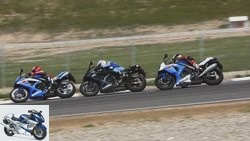
motorcycles
Suzuki GSX-R 600/750/1000
Fisherman’s Friends
read more
Related articles
-
Comparison test: touring motorcycles
fact 39 pictures fact 1/39 But now to the tourer bikes. The entry-level is the BMW R 1200 RT, which despite its mediocre engine with high-quality equipment, …
-
Comparison test Suzuki B-King, Yamaha MT-01 and Triumph Rocket III
fact 15 pictures artist 1/15 artist 2/15 artist 3/15 artist 4/15 artist 5/15 artist 6/15 artist 7/15 artist 8/15 artist 9/15 artist 10/15 artist …
-
Comparison test: Superbikes 2010
fact 42 pictures Jahn 1/42 Top handling and transparent feedback make the BMW S 1000 RR what it is. She also has a lot of electronic …
-
BMW, Ducati, Suzuki and Triumph super sports cars in a comparison test
29 pictures 1/29 Triumph Daytona 675, Ducati 848 Evo Corse SE, BMW S 1000 RR, Suzuki GSX-R 750. Different bikes – different …
-
Jahn comparison test of supersports: Ducati 998, Honda Fireblade, Kawasaki ZX-9R, Suzuki GSX-R 1000, Triumph Daytona 955i Centennial The K-Question Five …
-
Comparison test of the 600 super sports car
Comparison test of the 600 super athletes There is close turmoil in the athletes’ faction. A whopping 124 hp, a ridiculous 207 kilograms with a full tank, pure, sensual …
-
Yamaha, Triumph and Suzuki 600 super sports cars in comparison test
fact 600 super sports car 2011 from Yamaha, Triumph and Suzuki Test: Yamaha YZF-R6, Triumph Daytona 675 R, Suzuki GSX-R 600 Content from 2011 is the year …
-
Comparison test: MV Agusta Brutale, Triumph Street Triple, KTM Super Duke
fact comparison test: MV Agusta Brutale, Triumph Street Triple, KTM Super Duke Three naked bikes in direct comparison There are motorcycles for which …
-
Comparison test of superbikes, part 1: Country road
Jorg Kunstle 36 pictures 1/36 Comparison test Superbikes: Aprilia RSV4 RF, BMW S 1000 RR, Kawasaki ZX-10R, Yamaha YZF-R1M. 2/36 …
-
5 power naked bikes comparison test 2018
fact 27 pictures fact 1/27 Ducati Monster 1200, Honda CB 1000 R +, Kawasaki Z 1000 R Edition, Suzuki GSX-S 1000 and Triumph Speed Triple S in …